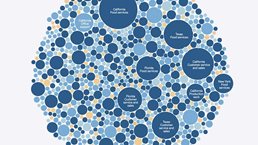The spread of coronavirus is leaving a wide swath of economic damage in its wake. Our initial analysis, conducted at the beginning of April, examined the impact at the state, national, and occupational level. We estimated that in the shutdown phase alone, up to 53 million US jobs were vulnerable—a term we use to encompass permanent layoffs, temporary furloughs, or reductions in hours and pay.
Since then, demand shocks have been reverberating through all sectors. Now that pandemic-related unemployment claims have been pouring in for several weeks, the losses associated with the initial shutdown are cascading into knock-on effects. While leisure and hospitality accounted for most of the earliest layoffs and furloughs, the share from industries such as retail trade, manufacturing, nonessential healthcare, and professional services has been growing. We estimate that up to 57 million US jobs are now vulnerable, including more and more white-collar positions. By way of context, some 59 million jobs are at risk in the European Union, the United Kingdom, and Switzerland, which have a considerably larger population.
We find significant overlap between the workers who are vulnerable in the current downturn and those who hold jobs susceptible to automation in the future. In addition to the effects of technology, the crisis itself may create lasting changes in consumer behavior and health protocols. To put vulnerable workers on more promising and sustainable paths, the US response should incorporate a longer-term view about the resulting occupational shifts and the development of skills.
Decisive action is critical. After every US recession since 1991, it has taken progressively longer for jobs to reappear. The United States did not regain the number of jobs it lost in the Great Recession until 2014. Given the depths of the current downturn, the country cannot afford to let history repeat itself—and it’s possible to make choices that will head off that outcome. But responding to the twin challenges of a public-health crisis and an economic downturn may require a new playbook, rapid innovation, learning, and adaptation.

The employment impact of COVID-19 across industries and occupations
More than 26 million Americans have applied for unemployment, but twice that number are vulnerable
About one in six US workers—more than 26 million Americans—filed for unemployment in the five weeks ending April 18. That number erases all of the net job gains since the Great Recession.
In the five weeks from March 15 to April 18, initial unemployment claims surged across the country. Florida, Georgia, Michigan, New York, Pennsylvania, and Texas each had more than a million residents filing for benefits; in California, the number surpassed three million. Viewing these numbers as a share of the total workforce illustrates the magnitude of the downturn (Exhibit 1). In five states—Hawaii, Kentucky, Michigan, Pennsylvania, and Rhode Island—a quarter or more of the workforce has applied for unemployment benefits.

Unemployment claims offer only a partial picture of workforce dislocations. Our analysis shows that more than twice as many workers are vulnerable to reduced hours, pay cuts, and temporary unpaid leave. Moreover, unemployment claims will undoubtedly rise in the weeks ahead as states work through a backlog of claims and more businesses that initially tried to maintain payrolls resort to furloughs and layoffs.
Job losses are rippling through multiple industries and occupations
An analysis of state-level data on initial unemployment claims shows that the earliest wave of job losses, in mid-March, disproportionately hit food service, entertainment, and accommodations. Subsequent weeks have seen a sharp pullback in consumer spending in most categories, leading to job losses in retail, business services, manufacturing, and non-essential healthcare (Exhibit 2).

Examining the week-by-week initial unemployment claims in specific states illustrates this pattern. In New York State, for example, most claims filed for the week ending March 21 came from leisure and hospitality, which accounts for just 10 percent of the state’s workforce. In later weeks, an increasing number of claims came from retail as well as professional and business services. In Michigan, leisure and hospitality accounted for 35 percent of the claims filed in the week ending March 21 but 12 percent in the week ending March 28. Meanwhile, the share from the manufacturing sector tripled.
Looking ahead, the loss of employment will likely continue to cascade. Strained budgets are beginning to force state and local governments to cut public-sector jobs. City governments from Cincinnati to Santa Barbara are already resorting to furloughs and layoffs. A drop in charitable giving is hitting nonprofits, and colleges are anticipating cutbacks. Consumers have been migrating to digital banking during the shutdown, so fewer bank employees may be needed in retail branches.
Online job postings provide an early gauge of hiring trends in specific occupations. Data from Emsi, which consolidates data from more than 100,000 websites, show that job postings have declined by roughly one million since February 2020—a drop of 16 percent.1 The biggest percentage decline came in postings for oil and gas operators (a drop of 56 percent), followed by food-machine operators, bakers, bellhops, auto-insurance appraisers, and parking-lot attendants (all of which declined by roughly 40 percent).
By contrast, demand is spiking for some roles. Translators saw the greatest increase as hospitals added interpreters to treat non-English-speaking COVID-19 patients. Other occupations experiencing a surge in hiring include respiratory therapists, general practitioners, psychiatrists, and epidemiologists (Exhibit 3).

Low-wage, part-time, and minority workers are the most likely to hold vulnerable jobs
While Americans of all backgrounds are feeling the economic pain, many of the newly unemployed in early March were part-time workers, young people, minorities, and women (Exhibit 4).

Our initial analysis, published in early April, found that 86 percent of jobs that the pandemic has made vulnerable paid less than $40,000 a year. Part-time workers were disproportionately represented. But as demand has fallen in multiple industries, growing numbers of full-time and white-collar jobs are being affected. Our updated model finds that as of mid-April, 16 percent of workers earning more than $70,000 a year have become vulnerable (Exhibit 5). However, almost three-quarters of all vulnerable workers earn less than $40,000 a year.2

Education: Workers without bachelor’s degrees are nearly twice as likely to hold vulnerable jobs. In MGI’s research on automation in the US labor market, educational attainment emerged as the strongest demographic predictor of future displacement risk. Today the pandemic has put the educational divide in stark relief. Workers without bachelor’s degrees are twice as likely to hold jobs we classify as vulnerable. They account for 58 percent of the US workforce but 82 percent of all vulnerable jobs.
Race: Minorities are more likely to hold vulnerable jobs, especially in large cities. The March 14 household survey data from the Bureau of Labor Statistics (BLS) show that racial minorities make up 20 percent of the labor force but 25 percent of the newly unemployed. This disparity may in part result from a difference in the ability to work from home. White workers are 37 percent more likely than their nonwhite counterparts to hold jobs that can be performed remotely.3
Race is an especially strong predictor of job vulnerability in many large cities where the people staffing retail shops, bars, and restaurants are disproportionately nonwhite. Nonwhite workers are 28 percent more likely than white workers to hold vulnerable jobs in Honolulu, 29 percent more likely in Albuquerque, and 30 percent in Washington, DC.
Age: Younger workers are 35 percent more likely to hold vulnerable jobs. March BLS household survey data show that younger workers were especially likely to be let go by employers. Workers under the age of 35 make up 36 percent of the US labor force but 49 percent of the newly unemployed. In part, this may reflect their greater propensity to hold part-time jobs and their lack of seniority. The generation that first entered the job market in the aftermath of the Great Recession is now going through its second “once in a lifetime” downturn.
Gender: Women sustained a majority of the initial job losses, but that may change going forward. The earliest job losses have hit women harder than men. March enterprise survey data from the BLS found that women made up 59 percent of the initial jobs lost.4 This occurred in part because they account for just under two-thirds of employment in leisure and hospitality, retail, education, and health—areas that accounted for 80 percent of the job losses from February 15 to March 14.5
Many women were also vulnerable by virtue of their part-time status (Exhibit 6).6 Women hold 63 percent of all part-time jobs, which are typically the first to be cut in any downturn. Part-time workers accounted for only 18 percent of the workforce in February but 46 percent of net new unemployment claims in March.

However, the gender disparity in initial job losses may rebalance over time. Our model finds that men are 10 percent more likely than women to hold vulnerable jobs. Job losses were more limited in male-dominated sectors such as construction and manufacturing in March, but they may be harder hit as time goes on. These two sectors combined account for as many vulnerable jobs as retail.
Employers and governments have multiple issues to solve
The ultimate economic impact of the COVID-19 pandemic will be partially determined by how effectively policy makers and business leaders can mitigate structural damage to the economy while containing the virus. While the situation is evolving rapidly, it is clear that supporting the workers and businesses that are losing income during the initial lockdown is a priority. Policy makers have created significant fiscal-relief programs to support workers and businesses; the challenge now is to operationalize those measures. But in this highly fluid environment, the public and private sectors alike will need to adapt and innovate, learn what works and what doesn’t, and adjust as they go.
The issues facing companies
One of the lessons of the last downturn is that completely severing the relationship between employers and employees tends to lengthen unemployment. To the extent that companies can implement reduced hours, temporary furloughs, or creative job-sharing and redeployment programs instead of outright layoffs, the entire economy will be better positioned for a faster and stronger recovery. The Payroll Protection Program, for example, is meant to cover payroll costs so that small businesses can keep workers employed.7
When furloughs and layoffs are unavoidable, employers can take steps to help the newly unemployed land on their feet. Participating in digital platforms can help furloughed and laid-off workers connect with organizations that need temporary help to meet surging demand. Some companies that are downsizing are already forming direct partnerships with organizations that are hiring to help make these workforce transitions faster and more seamless. Furloughs can also provide a window, through online training, for employees to develop the skills that employers envision needing in the future.
Many businesses have rapidly shifted to remote work. But as schools around the nation shut down, working mothers have had to take on more child care. In addition to federally mandated paid sick leave under the Families First Coronavirus Response Act, companies can offer greater flexibility to support parents working from home. To prevent a worsening of gender disparities, it will be important for companies to take parenting responsibilities into account in the current environment.
As companies look ahead to an eventual reopening, they are thinking about how to operate safely, given the need to prevent wider outbreaks and build consumer confidence. This may involve reconfiguring shared office spaces, adding plexiglass screens between customers and frontline workers, acquiring adequate supplies of personal protective equipment (PPE), creating new health protocols, or shifting more work online. Companies that serve the public will have to make adjustments to improve the comfort level of consumers, such as limiting density in commercial spaces, conducting temperature checks, and using contactless payment and pickup methods. The current crisis is forcing innovation on the fly, so employers can also reimagine workplaces and workflows.
The issues facing policy makers
The deluge of unemployment claims has created significant delays for people who urgently need money in their pockets. A number of states have reduced the backlog by adding staff or upgrading digital processing. If shutdowns need to be prolonged to protect public health, policy makers may need to consider extending this lifeline. Although freelancers and gig workers are now eligible for unemployment, many have found it difficult to navigate application processes that were not developed with their situations in mind. States including Massachusetts are trying to address this problem by setting up portals specifically for independent workers.
To supplement federal loan programs, many states are offering small businesses no- or low-interest emergency bridge loans or grants. Similar programs have been rolled out at the city level in places such as Chicago, Oklahoma City, and San Francisco. A number of cities and states have paused both residential and commercial evictions. California’s state government brought together a consortium of major lenders to offer forms of relief such as grace periods on mortgage payments.
State workforce agencies may also choose to design new education and training programs with the specific goal of helping unemployed workers without college degrees increase their employability when the economy reopens—and for the longer term as well. This could involve courses for high-school-equivalency certificates, remedial courses in literacy and numeracy, and online community-college programs that teach specialized skills required for high-demand jobs (such as nursing).
To reopen economies safely, government officials can work collaboratively with employers to set standards for safe workplaces and consumer protocols, as well as issues such as acquiring enough PPE for industries to operate. Communities need large-scale systems for testing and contact tracing. Addressing such pandemic-related needs can create work for unemployed Americans. California is taking a similar approach with a new program that will use funding from the Federal Emergency Management Agency to pay restaurants to provide home-meal deliveries to seniors in need. Public health and economic recovery are intertwined, and they can be addressed in tandem.
The pandemic is accelerating structural shifts in the economy that were already underway, such as using digital channels to reach consumers, automating operations, and allowing people to work remotely from home. Moreover, some shifts in consumer behavior and demand for new types of work may outlast the current public health crisis. Preparing for the “future of work” has gone from a distant hypothetical to a very immediate priority. Tens of millions of workers need support not only to get through today’s challenges but also to put themselves on a better footing for the future. In the months ahead, we will continue with our ongoing research to track these trends.


